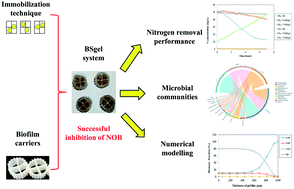当前位置:
X-MOL 学术
›
Environ. Sci.: Water Res. Technol.
›
论文详情
Our official English website, www.x-mol.net, welcomes your
feedback! (Note: you will need to create a separate account there.)
Enhancement of mainstream nitrogen removal via simultaneous partial nitrification, anammox and denitrification by the gel entrapment technique
Environmental Science: Water Research & Technology ( IF 3.5 ) Pub Date : 2020/01/02 , DOI: 10.1039/c9ew00906j Ming Zeng 1, 2, 3, 4 , Junfeng Yang 1, 2, 3, 4 , Xiaofang Li 1, 2, 3, 4 , Nan Wu 4, 5, 6, 7 , Peng Pan 1, 2, 3, 4 , Chang Wang 1, 2, 3, 4
Environmental Science: Water Research & Technology ( IF 3.5 ) Pub Date : 2020/01/02 , DOI: 10.1039/c9ew00906j Ming Zeng 1, 2, 3, 4 , Junfeng Yang 1, 2, 3, 4 , Xiaofang Li 1, 2, 3, 4 , Nan Wu 4, 5, 6, 7 , Peng Pan 1, 2, 3, 4 , Chang Wang 1, 2, 3, 4
Affiliation

|
Recently, mainstream anaerobic ammonium oxidation (anammox) has attracted extensive attention due to its energy-neutral advantages. The inhibition of nitrite oxidizing bacteria is a key factor to guarantee the occurrence of the anammox process, which is usually achieved by controlling the aeration conditions. This study integrates the gel entrapment technique with a traditional biofilm (abbreviated as BSgel system) to realize a simultaneous partial nitrification, anammox and denitrification (SNAD) process. The anammox biofilm on the surface of the carrier was covered by the gel with entrapped activated suspended sludge. The results show that the SNAD process successfully took place in the BSgel, while the traditional hybrid system of biofilm and suspended sludge only yielded the nitrification process. Furthermore, the hindrance effect of high organic matter concentration (up to 100 mg L−1 COD) was weakened and the specific total inorganic nitrogen (TIN) removal rate reached 57 mg N (gVSS d)−1 in the BSgel. However, the low temperature (15 °C) reduced the nitrogen removal potential. Besides, the BSgel system showed a reactivation ratio of nitrogen removal ability of 68% after preservation at −20 °C for one month. The high-throughput sequencing analysis indicates that the BSgel system combined the common microbial community characteristics of both the biofilm and suspended sludge. The dominant anammox group belonged to Candidatus Kuenenia. Finally, the numerical modelling predicts the microbial and nutrient profiles in the gel film of partially entrapping and fully entrapping BSgel systems, indicating that the fully entrapping pattern outperformed the partially entrapping pattern. Overall, our findings support that the BSgel system facilitates the SNAD process under mainstream conditions within a short time.
中文翻译:

通过凝胶截留技术同时进行部分硝化,厌氧氨化和反硝化,提高主流氮的去除率
近来,主流的厌氧铵氧化(anammox)由于其能量中立的优势而引起了广泛的关注。抑制亚硝酸盐氧化细菌是保证厌氧氨氧化过程发生的关键因素,这通常是通过控制通气条件来实现的。这项研究将凝胶捕获技术与传统生物膜(缩写为BSgel系统)相结合,以实现同时进行部分硝化,厌氧氨化和反硝化(SNAD)过程。载体表面上的厌氧生物膜被捕获的活性悬浮污泥覆盖。结果表明,SNAD过程在BSgel中成功进行,而传统的生物膜和悬浮污泥的混合系统仅产生硝化过程。此外,BSgel中的-1 COD)减弱,特定总无机氮(TIN)去除率达到57 mg N(gVSS d) -1。但是,低温(15°C)降低了脱氮潜力。此外,BSgel体系在-20℃保存1个月后,脱氮能力的再活化率为68%。高通量测序分析表明,BSgel系统结合了生物膜和悬浮污泥的共同微生物群落特征。占主导地位的厌氧氨氧化菌群属于加拿大念珠菌。最后,数值模型预测了部分捕获和完全捕获BSgel系统的凝胶膜中的微生物和营养状况,表明完全捕获模式优于部分捕获模式。总体而言,我们的发现支持BSgel系统在短时间内在主流条件下促进了SNAD流程。
更新日期:2020-03-05
中文翻译:

通过凝胶截留技术同时进行部分硝化,厌氧氨化和反硝化,提高主流氮的去除率
近来,主流的厌氧铵氧化(anammox)由于其能量中立的优势而引起了广泛的关注。抑制亚硝酸盐氧化细菌是保证厌氧氨氧化过程发生的关键因素,这通常是通过控制通气条件来实现的。这项研究将凝胶捕获技术与传统生物膜(缩写为BSgel系统)相结合,以实现同时进行部分硝化,厌氧氨化和反硝化(SNAD)过程。载体表面上的厌氧生物膜被捕获的活性悬浮污泥覆盖。结果表明,SNAD过程在BSgel中成功进行,而传统的生物膜和悬浮污泥的混合系统仅产生硝化过程。此外,BSgel中的-1 COD)减弱,特定总无机氮(TIN)去除率达到57 mg N(gVSS d) -1。但是,低温(15°C)降低了脱氮潜力。此外,BSgel体系在-20℃保存1个月后,脱氮能力的再活化率为68%。高通量测序分析表明,BSgel系统结合了生物膜和悬浮污泥的共同微生物群落特征。占主导地位的厌氧氨氧化菌群属于加拿大念珠菌。最后,数值模型预测了部分捕获和完全捕获BSgel系统的凝胶膜中的微生物和营养状况,表明完全捕获模式优于部分捕获模式。总体而言,我们的发现支持BSgel系统在短时间内在主流条件下促进了SNAD流程。











































 京公网安备 11010802027423号
京公网安备 11010802027423号